
Related
This month marks the 25th Anniversary of the Greensboro Massacre, when forty Ku Klux Klansmen and American Nazis opened fire on an anti-Klan demonstration in Greensboro, North Carolina. Five people were killed. No one was convicted. We speak with two of the survivors. [includes rush transcript]
“On November 3, 1979, at the corner of Carver and Everitt Streets, black and white demonstrators gather to march through Greensboro, North Carolina, a legal demonstration against the Ku Klux Klan. A caravan of Klansmen and Nazis pull up to the protesters and open fire
“Eighty-eight seconds later, five demonstrators lie dead and ten others wounded from the gunfire, recorded on camera by four TV stations. Four women have lost their husbands, three children have lost their fathers.
“After two criminal trials, not a single gunman has spent a day in prison, although a civil trial won an unprecedented victory for the victims: For one of the only times in US history, a jury held local police liable for cooperating with Ku Klux Klan in a wrongful death.”
That is the introduction to the book: Through Survivors” Eyes: From the Sixties to the Greensboro Massacre written by one of the survivors, Sally Bermanzohn. This month marks the 25th anniversary of the Greensboro Massacre. We will speak with two of the survivors, but first let’s go back to that fateful day 25 years ago.
- Scenes from the Greensboro Massacre, excerpt from “Guns of November 3rd”, courtesy of Jim Waters
Images and sounds from the 1979 Greensboro Massacre from the documentary “The Guns of November 3rd”, Courtesy of Jim Waters. This month marks the 25th anniversary of the Greensboro Massacre. Last weekend, as many as 700 people marched to Greensboro’s City Hall following the route of the planned 1979 march. They finished the march that never began 25 years ago.
The survivors of the Greensboro Massacre are forming the country’s first Truth and Reconciliation Commission.
- Sally Bermanzohn, one of the survivors of the Greensboro Massacre in which her husband, Paul, was critically wounded. She is now associate professor of politics at Brooklyn College, CUNY, where she teaches courses on politics, race, gender, and class. She recently wrote the book Through Survivors” Eyes: The Sixties through the Greensboro Massacre.
- Rev. Nelson Johnson, survivor of Greenboro Masacre. He was one of the organizers of the anti-Klan rally in 1979. He is now the Executive Director of the Beloved Community Center in Greensboro.
Transcript
AMY GOODMAN: This month marks the 25th anniversary of the Greensboro Massacre. Today we speak with two of the survivors. But first, let’s go back to that fateful day, 25 years ago.
VIRGIL GRIFFIN: We can take our country back from the Communist Party, we can take it back from the niggers. It’s time for us to band together. If we have to git in the streets and fight in blood up to our knees, by God, it’s time to git ready to fight! Give them what they want! Fight for this country! [chanting] [shouting]
PROTESTER: They had it planned!
PROTESTERS: Help us! Help us!
PROTESTER: The Klan and the state got together and planned this. That’s why they were not [inaudible]. Do you hear me? The state protects the Klan and this makes it clear. They came through and they opened fire. They opened fire on us! And we fired back to protect ourselves.
PROTESTER: The Klan or whoever it was jumped out and just started shooting in the direction of the thickest concentration of people. They seemed to be aiming at particular people. There were several police in the area who did nothing until after these murderers left. Police came in, immediately started arresting people who were trying to help those who had fallen. Nelson Johnson was taken into custody, kicked in the head by the police. He was bleeding from the arm as he was trying to help people. The police did this, directly or indirectly. They set it up.
PROTESTER: This will never happen again! We will never [inaudible]. He didn’t have a gun on him. Oh, God! [inaudible][sobbing]
AMY GOODMAN: Images and sounds of the 1979 Greensboro Massacre, brought to us courtesy of Jim Waters, one of camera people that day, put together a piece called “The Guns of November 3.” This month marks the 25th anniversary of the Greensboro Massacre. Last weekend, as many as 700 people marched to Greensboro City Hall following the route of the planned 1979 march. They finished the march that never was completed 25 years ago. The survivors of the Greensboro Massacre are forming the country’s first Truth and Reconciliation Commission, based on the South African model. We’re joined by Reverend Nelson Johnson, survivor of the Greensboro Massacre, one of the organizers of the anti-Klan rally of 1979, now the executive director of the Beloved Community Center in Greensboro. Also in our studio here in New York, Sally Bermanzohn, one of the survivors also of the massacre in which her husband Paul was critically wounded. She is now Associate Professor of Politics at Brooklyn College where she teaches classes on politics, race, and gender, and she has authored the book Through Survivors’ Eyes: The Sixties Through the Greensboro Massacre. We welcome you both to Democracy Now! Sally Bermanzohn, the beginning of the video-audio clip that we just played, we heard a man, you know, talking about going after African Americans, using the n-word. Who was he?
SALLY BERMANZOHN: His name was Virgil Griffin. He is still a leader of a Klan and he was in the lead car that came in and attacked our march.
AMY GOODMAN: So, that man that we saw addressing a crowd —
SALLY BERMANZOHN: Yes.
AMY GOODMAN: That you had footage of.
SALLY BERMANZOHN: Yes.
AMY GOODMAN: Came then and attacked the protest. Why the protest? Let me put that question to Reverend Nelson Johnson, since you were one of the organizers of it. Why did you protest that day on November 3? Where were you trying to get to, from where to where?
REV. NELSON JOHNSON: Essentially the same place we should be trying to get to now. That we were actually doing labor organizing and racial justice organizing and the Klan — and that way of thinking, whether it’s named Klan or not, resisted that in one of the most virulent forms of trying to create fear and promote falsehood and engender confusion through the threat and the use of force has been the Klan. It was so very important and is so very important that people who stand for justice resist this. So the short answer is that it was absolutely necessary to have some expression of opposition to racism as manifest by the Klan in order to continue with the work of labor organizing in the textile industry and in order to continue with the work of uniting people from different racial backgrounds. Those questions were necessary and that was at the base of the reason for the march in 1979.
AMY GOODMAN: Sally, so explain how it went down that day on November 3. What time did you gather?
SALLY BERMANZOHN: We gathered — the march was supposed to start at noon. At 11:23, while we were just gathering, before the march began, this caravan drove up and opened fire.
AMY GOODMAN: Did you know anything was going to happen?
SALLY BERMANZOHN: No, we had no idea. We had a legal police permit. The police were supposed to be there to protect the march like they do for every other march. There were no police around. Actually, there were police who were following the caravan in, who knew its every move as it approached us and they knew that it had guns, they had watched them all morning. They were in direct contact with the headquarters, police headquarters. They followed this death squad as it approached us, as it pulled out guns and opened fire and killed five people. So, there actually were police there, although they were not in uniform and they did nothing, nothing to protect the demonstrators, even though that was their obligation.
AMY GOODMAN: What happened to your husband, Paul?
SALLY BERMANZOHN: He was shot in the head and the arm. He is still partially paralyzed from that. He had five hours of surgery that night. We really were very — it was wonderful that he survived. It was a surprise that he survived.
AMY GOODMAN: Reverend Nelson Johnson, did you recognize people who were shooting you?
REV. NELSON JOHNSON: I did not. I later came to understand that one of the men who was driving the lead vehicle had been at a press conference that we held, and he was the agent of the Greensboro Police Department who was also a Klansman and an informant for the F.B.I., and he was the person to whom the Greensboro Police Department gave the parade permit either before or at about the same time that it was given to us, and that is a long story that I won’t get you into, but it was hard for us to get the parade permit and all the clearances, and there were never any reason given other than people were out of town and things that just doesn’t work for a government. That’s not the way a government works.
AMY GOODMAN: Reverend Johnson, what happened to you that day?
REV. NELSON JOHNSON: Well, I actually was very close to Sally Bermanzohn, and a Nazi member charged me with a knife and fortunately someone threw me a stick and I was defending myself. So, I got cut above the hands and stabbed through the arm as the person was trying to cut my mid section.
AMY GOODMAN: In the video footage, we see the police going after you, is that right?
REV. NELSON JOHNSON: Well, because I negotiated the parade permit with the police, I perhaps more than anyone else, was pretty clear that the whole arrangement that we made with the police had been betrayed. And I stood up to say that there isn’t any way this could happen without the police and the police then came and demanded that I be quiet and when I refused to do so, they arrested me and threw me to the ground and the man who became the police chief had his foot on my neck and I was bleeding pretty profusely at the time from the knife wound. So, that may be some of what you’re referring to.
AMY GOODMAN: Did they arrest you?
REV. NELSON JOHNSON: They arrested me and held me, did not set a bond. As a matter of fact, I’ve had seven charges brought against me directly growing out of the incident of 1979. And I have been in jail under a bond twice that of any Klansperson. I was once in jail for under the $50,000, allegedly for using bad language. And the Klansmen were in for murder for $50,000, so if you work with that, it gives you a sense of the atmosphere, which was unbelievable, except for those of us who were in it. It is not something that I often share in detail because it doesn’t really make sense to many people around the country.
AMY GOODMAN: Sally Bermanzohn, we only have a minute and I wanted to ask about the Truth and Reconciliation Commission. It is the first in this country. Explain what’s happening.
SALLY BERMANZOHN: Well, it is a project of the broad sectors of the Greensboro community, that the religious sectors from all different types of religious groups, the universities, the student governments, civic and civil rights organizations, as well as the survivors, have been very involved in it. It’s the first Truth in Reconciliation Commission in the United States, and it’s also the first one worldwide that is based in a city that’s an individual community process. I think that it’s a wonderful model that could address all kinds of other racial violence that this country has been so plagued by for hundreds of years.
AMY GOODMAN: The former mayor of the city, Jim Melvin, is opposed to the formation of this?
SALLY BERMANZOHN: Yes, he is.
AMY GOODMAN: Why?
SALLY BERMANZOHN: Well, he was the mayor when this happened. It was his police who did not protect the demonstrators and who — and he played a big role in at least covering up what had actually gone on.
AMY GOODMAN: Well, we hope to come back to this story. It’s a very important one. I want to thank you both, Sally Bermanzohn and Rev. Nelson Johnson, for joining us. Sally Bermanzohn’s book is called Through Survivors’ Eyes: The Sixties Through the Greensboro Massacre. It was just published, it’s the 25th anniversary of the Greensboro Massacre.

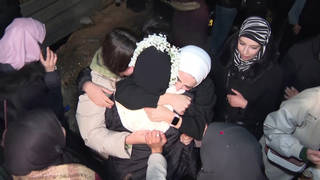
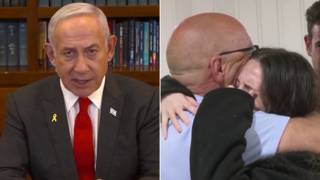
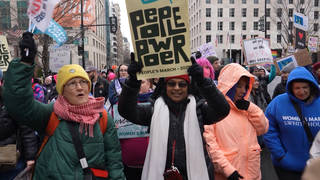
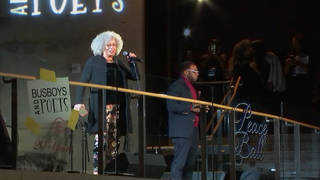
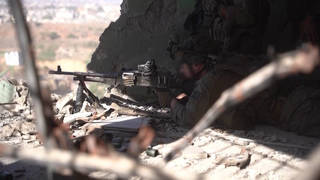




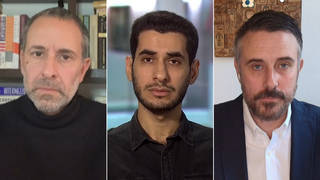
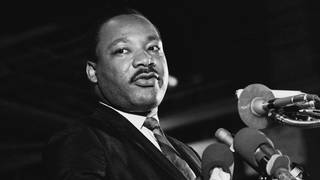
Media Options